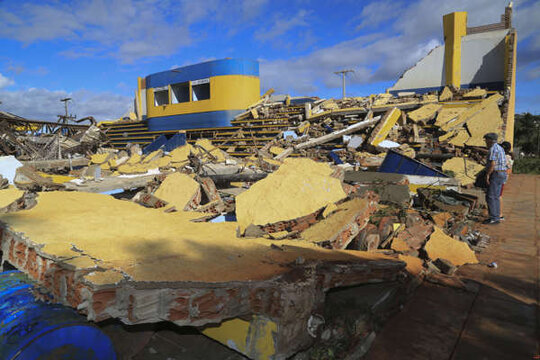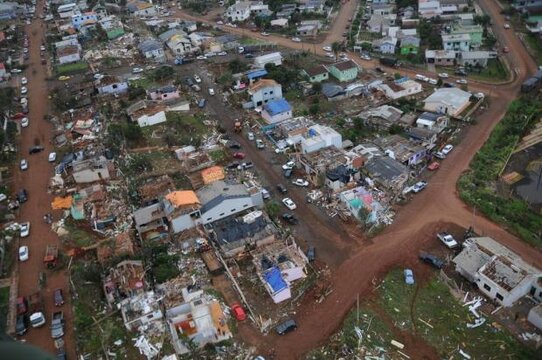Tyger
Paranormal Adept
SOTT Earth Changes Video Summary - March 2015
TEXT: "Published on Apr 8, 2015: This is the March installment of SOTT.net's 'Earth Changes Video Summaries', showing Extreme Weather, Planetary Upheaval, and Meteor Fireballs during the month of March 2015
"Planetary upheaval continued apace in March 2015, with intense flash-flooding occurring all across Latin America, and washing away entire towns. Overnight, the Atacama Desert in Chile, the 'driest place on Earth', became one of the wettest. Melting snow combined with unseasonal rains to flood parts of Northern India, the U.S. Midwest and Western Europe, while flooding also hit Eastern Africa and Australia. One of the strongest ever cyclones in the South Pacific devastated Vanuatu, while Super-Typhoon Maysak bore down on the Philippines at the end of the month. Just as Americans living in Tornado Alley were wondering where 'tornado season' had gone, a powerful multi-vortex twister scourged Moore, Oklahoma (again).
"With snow on the ground in 49 out of 50 U.S. states on March 1st, all month long heavy snowfall continued across the eastern half of North America. Boston broke its winter snowfall record - 9 feet of snow... and the same amount fell in ONE DAY in Central Italy last month! The extreme cold in the U.S. Northeast continued to set record-breaking temperatures, and brought sea ice up to previously unseen levels. No matter the season or location, tropics or desert, hail fell everywhere: several inches in Southern California and Saudi Arabia, TWO FEET in Bogota, Colombia, and softball-sized hail in Eastern Australia. From space, large meteor fireballs were seen from across the U.S. Mountain West, Central Europe, and Western Australia, while the planet was bathed in green and pink as the strongest auroras during this solar cycle reached extreme latitudes in both hemispheres.
"Wildfires in the Southern Hemisphere hit Valparaiso, Chile (again), and 'fire-nadoes' several stories tall formed outside Cape Town, South Africa. Spectacular volcanic eruptions last month included Villarica volcano in Chile spewing lava 1km into the night sky, Turrialba volcano in Costa Rica having its most powerful eruption in 20 years, and Colima volcano in Mexico sending ash 3km high. The combined effects of these climate extremes are giving rise to ever more mass animal deaths, with notable fish and bird kills along the Western Americas last month. Meanwhile in Holland, a wolf was spotted for the first time in 150 years as the species continues its westwards spread across Europe."
"Planetary upheaval continued apace in March 2015, with intense flash-flooding occurring all across Latin America, and washing away entire towns. Overnight, the Atacama Desert in Chile, the 'driest place on Earth', became one of the wettest. Melting snow combined with unseasonal rains to flood parts of Northern India, the U.S. Midwest and Western Europe, while flooding also hit Eastern Africa and Australia. One of the strongest ever cyclones in the South Pacific devastated Vanuatu, while Super-Typhoon Maysak bore down on the Philippines at the end of the month. Just as Americans living in Tornado Alley were wondering where 'tornado season' had gone, a powerful multi-vortex twister scourged Moore, Oklahoma (again).
"With snow on the ground in 49 out of 50 U.S. states on March 1st, all month long heavy snowfall continued across the eastern half of North America. Boston broke its winter snowfall record - 9 feet of snow... and the same amount fell in ONE DAY in Central Italy last month! The extreme cold in the U.S. Northeast continued to set record-breaking temperatures, and brought sea ice up to previously unseen levels. No matter the season or location, tropics or desert, hail fell everywhere: several inches in Southern California and Saudi Arabia, TWO FEET in Bogota, Colombia, and softball-sized hail in Eastern Australia. From space, large meteor fireballs were seen from across the U.S. Mountain West, Central Europe, and Western Australia, while the planet was bathed in green and pink as the strongest auroras during this solar cycle reached extreme latitudes in both hemispheres.
"Wildfires in the Southern Hemisphere hit Valparaiso, Chile (again), and 'fire-nadoes' several stories tall formed outside Cape Town, South Africa. Spectacular volcanic eruptions last month included Villarica volcano in Chile spewing lava 1km into the night sky, Turrialba volcano in Costa Rica having its most powerful eruption in 20 years, and Colima volcano in Mexico sending ash 3km high. The combined effects of these climate extremes are giving rise to ever more mass animal deaths, with notable fish and bird kills along the Western Americas last month. Meanwhile in Holland, a wolf was spotted for the first time in 150 years as the species continues its westwards spread across Europe."



 - I have an interest in the arcane. In astrology the 'age' we are entering will have many 'implosions' but they will be mini or of a nature that we always recover. The implosions will just keep happening - but there will never be one granddaddy of an earthy change 'in a twinkling'.
- I have an interest in the arcane. In astrology the 'age' we are entering will have many 'implosions' but they will be mini or of a nature that we always recover. The implosions will just keep happening - but there will never be one granddaddy of an earthy change 'in a twinkling'.
